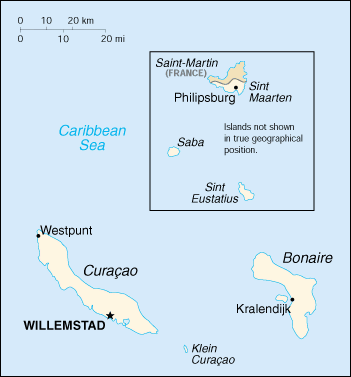America > Netherlands Antilles: Weather, Map, Costs and Travel Guide

Netherlands Antilles : When and where to go?
Click on a city for complete climate and weather tables
| Town | Jan | Feb | Mar | Apr | May | June | July | Aug | Sept | Oct | Nov | Dec |
| Willemstad |  |  |  |  |  |  |  |  |  |  |  |  |
Netherlands Antilles: Climate & Weather
The Netherlands Antilles suffers from a tropical climate, with a more humid atmosphere and risks of cyclones for the Windward Islands between August and October: the rainy season runs from June to October.
The Leeward Islands experience warmer and sunny weather, with an average of 27 ° C throughout the year and a very short rainy season between October and December.
For a discovery of all the islands, it is better to prefer a stay between February and April.
Weather today

Mostly Cloudy
Wind: 11 km/h
Precipitation forecast: 0 mm
> Full report and 7-days forecast
Data updated at 07:44 (local time)
At that time, the weather was:
 28 °C / Partly Cloudy
28 °C / Partly Cloudy
Netherlands Antilles: Map

Sponsored links
What to do in Netherlands Antilles
Bonaire: the largest of the Leeward Islands has fabulous diving sites where abundant black corals, but also wild donkeys and numerous pink flamingos abound. Kralendijk, the only city on the island, has just over 3000 inhabitants, and you will notice its yellow houses with red roofs, very characteristic.
Curaçao: first visit Willemstad, the main city, nicknamed the Amsterdam of the Tropics, with its pretty harbor and its colored houses facades. The population comprises a population of multiple origins, including a majority of African origin. The highest point of the island is the Christoffelberg, at 375 meters above sea level. Formerly a hunt for pirates, it was also the world center of the cocoa trade. Today, there are many creole creations, dances and a very mixed cuisine, and an economy that relies mainly on tourism, finance (it is a tax haven) and the oil industry. Several museums are to be visited.
Saint-Martin: close to Saint-Barth, this wind island is partly a French community, and its great interest lies in the fauna and flora that populate its coral reefs and mangroves.
Saint-Eustache: to the south of the island, Oranjestad, with its fort, built of volcanic stones, where the canons remain in perfect condition, and beautiful colonial houses of the 18th century. You can also visit the botanical gardens, the museum housed in the former Simon Docker House, and for diving enthusiasts the remains of the many 17th and 18th century boats that sank all around the island. The highest point is the Quill, at 602 meters.
Netherlands Antilles: The basics
The current currency is the West Indian guilder (ANG), except in Saba where it is the US dollar (USD).
We land at the Princess Julian airport in Sint Maarten, but we can reach the other islands by plane.
To get around you can rent a car, but there is also good public transport (bus) on some islands, such as Curaçao. The bike can also be used very easily.
For a basic budget, count between $ 30 and $ 40 per day.
There are no particular health problems (good protection from the sun) or safety.
To bring back, the Curaçao liqueur of course!



